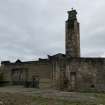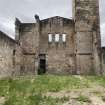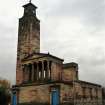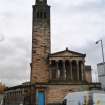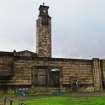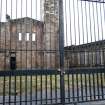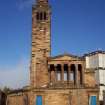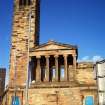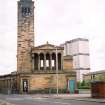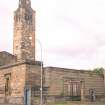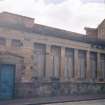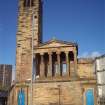Notice
Following a review of the Buildings at Risk Register we have paused the Register while we consider options for its future.
The website will remain accessible and searchable during this time, but it will not be updated and we’re not accepting nominations for additions to the Register. If you need to contact us about the BARR please email hmenquiries@hes.scot
Read the review report here and you can find out more about why we have paused the BARR on our news centre.
Caledonia Road United Presbyterian Church (Former), 1, Caledonia Road, Gorbals
Ordnance Survey licence number AC0000807262. All rights reserved. © Copyright and database right 2025. Public Sector Viewing Terms
Useful Links
- Canmore:
- GLASGOW, 1 CALEDONIA ROAD, CALEDONIA ROAD UNITED PRESBYTERIAN CHURCH
- Historic Scotland:
- HS Reference No 33497
General Details and Location
Category
AT RISK
Name of Building
Caledonia Road United Presbyterian Church (Former)
Other Name(s)
Hutchesontown and Caledonia Road Church (Former)
Address
1, Caledonia Road, Gorbals
Locality
Postcode
Planning Authority
Divisional Area
Reference No
1429
Listing Category
A
OS Grid Ref
NS 58932 63852
Location Type
Urban
HS Reference No
33497
Description
Church and hall on gusset site, burnt out 1965. Banded ashlar on polygonal masonry base. South elevation: temple front raised over ground floor banded masonry podium with 2 boldly detailed corniced doorpieces with Greek motifs and antifixae. Original wooden doors. Ionic pedimented hexastyle portico above. East elevation: banded masonry and 3 blank corniced windows with discs. Low door at north end. Only 1-bay of gallery level remains. West elevation: 1-storey hall with 9 pilastered windows, now blank and 2 doors in architraves and frieze under small paired windows. The doors are concrete replicas of wooden doors. Tall square tower of banded masonry with 3 narrow openings near the top, a lantern and cross. Small section of cast iron railings at base. Rear wall modern. Interior gutted. (Historic Scotland)
The church, Alexander Thomson's first, was erected together with two adjoing tenements in Cathcart Road and Hospital Street as an architectural grouping, with coursing of stonework and window detailing for example, being carried across all three buildings. The ruin of the church being one of the few remaining early features of 19th century Gorbals to remain (Glasgow City Council)
The church, Alexander Thomson's first, was erected together with two adjoing tenements in Cathcart Road and Hospital Street as an architectural grouping, with coursing of stonework and window detailing for example, being carried across all three buildings. The ruin of the church being one of the few remaining early features of 19th century Gorbals to remain (Glasgow City Council)
Building Dates
1856
Architects
Alexander "Greek" Thomson
Category of Risk and Development History
Condition
Ruinous
Category of Risk
High
Exemptions to State of Risk
Field Visits
October 1992, June 2004, 5/11/2007, 16/11/2010, 25/3/2014, 24/05/2023
Development History
1963: The congregation vacates the church, which is then purchased by Glasgow District Council. October 1965: The church is gutted following an arson attack. It is subsequently partially demolished. October 1992: External inspection reveals the church to be a burnt out shell, isolated by roads on all sides. Although owned by Glasgow District Council, it is currently on a 60-year lease and the leaseholder has planning consent for a restaurant conversion. However, feasibility studies by the Glasgow Building Preservation Trust have shown that at least £1.8 million would be required for restoration. January 1994: Local planners report that some emergency repairs have been carried out. 31 January 1995: Press reports note that the London-based Historic Buildings Trust has launched a plan to redirect the traffic flows around the building by realigning roads and demolishing railway arches. October 1995: Local planners report that Glasgow District Council has adopted HBT's plan to demolish the redundant railway viaduct to the west of the church. However, the re-routing of the main road has been rejected. A restored church would therefore remain cut off from the proposed new housing to the east. Historic Scotland has asked Glasgow Building Preservation Trust to investigate new uses for the church. April 1996: Permissions are sought for fabric repairs and the erection of floodlighting as part of the Crown Street Regeneration Project to develop brownfield sites in the Gorbals. SCT welcomes the proposals and permissions are subsequently granted with conditions. 8 July 1996: The Scotsman reports that the Iona Community is considering the possibility of making the building its headquarters. 9 July 1996: The Glasgow Evening Times reports that Historic Scotland and the organisers of Glasgow's 1999 City of Architecture festival are keen to see the building restored. Religious charity the Iona Community has been in discussions with the Glasgow Building Preservation Trust with regards to basing its mainland HQ in the church. 8 December 1997: The Herald reports that Glasgow City Council has drawn up 3 options for the surrounding road layout. The preferred option is to move the extension of Cathcart Road in order to provide space around the church and ease traffic flow on the east side. The church would be fronted by a paved area. The private development of tenemental properties, which would adjoin the church as in the original designs, could help to pay for the plans. June 1998: A Development Design Guide for the church and the surrounding area is prepared by Glasgow City Council. It is trying to put together a joint funding package with the Crown Street Regeneration Project which would permit essential repairs and stabilisation works to be undertaken. 27 July 1999: The Herald reports that repairs works will commence in September, following £250,000 of joint funding from Glasgow City Council, Historic Scotland and the Glasgow Development Agency. A £10 million financial package to allow permanent restoration is being put together with the Crown Street Regeneration Project. Lauriston Road will be realigned to the west so that the church is no longer isolated and is joined to the rest of the Crown Street development. 29 July 1999: The Scotsman repeats the story. 5 August 1999: The Glaswegian repeats the story. 2002: Local planners report that integration with the New Gorbals development will be investigated once the routes of the proposed M74 extension and Carmunnock Rail Link are finalised. June 2004: External inspection reveals the church to remain ruinous and isolated. November 2007: External inspection reveals the property remains ruinous. That the doors appear to have been recently repainted, and as foliage growth is quite low, suggests regular maintenance is taking place.
20 April 2009: The Herald reports that planning permission has been lodged for the former church to convert it into a study centre/display area on the works of "Greek" Thompson. The Daily Record repeats the story.
June 2009: The planning application for the redevelopment of the church was brought before the Glasgow Urban Design Panel. The proposals are for a mixed use development comprising: Alexander Thomson Gallery & Museum, café/bar and 10 serviced apartments.
September 2009: The Herald reports that detailed plans for reuse and development of the former church by the Alexander Thomson Society have been approved by Glasgow City Council, subject to conditions on materials. The plans includes the creation of three galleries, a public study area for Thomson material, a cafe bar, meeting rooms and a new build 10 apartments for tourist accomodation. The article goes on to note that the New Glasgow Society raised concerns over the scale of the proposals for the site, and that the proposed newbuilt would dominate the church.
The Evening Times repeats the story.
The Evening Times repeats the story.
January 2010: The Herald reports on the public appeal to raise funds for the conversion and conservation works to the church. See the Greek Thomson Society website for more details. http://www.greekthomson.org.uk
February 2010: Glasgow City Council's Glasgow Magazine reports on the launch of the public appeal to secure development funds.
November 2010: External inspection finds the building remains ruinous. The only roofed sections are the tower and the temple, both of which are suffering from damp. This is also a problem in some other parts of the structure.
25 October 2013: Local planners advise fundraising for the redevelopment of the site continues.
25 March 2014: External inspection finds the building remains in much the same condition as seen previously as a stabilised ruin.
24 May 2023: External inspection finds that the building is generally in similar condition as previous assessments. There are signs of stone decay and damp. There is movement of the blocks that flank the entry at the southeast. Propping appears to be in place in the windows of the upper south elevation. The doors and gate appear secure.
Guides to Development
Conservation Area
Planning Authority Contact
PAC Telephone Number
0141 287 5492
Availability
Current Availability
Not Available
Appointed Agents
Price
Occupancy
Vacant
Occupancy Type
N/A
Present/Former Uses
Name of Owners
Glasgow City Council
Type of Ownership
Local Authority
Information Services
Additional Contacts/Information Source
Alexander Thomson Society, 7 Walmer Crescent, Glasgow G51 1AT http://www.greekthomson.org.uk/index.htm
Bibliography
Buildings of Scotland Glasgow Williamson, Riches and Higgs (1990), Caledonia Road Church Development Design Guide (Draft) Glasgow City Council
Online Resources
The Glasgow Story: http://www.theglasgowstory.com/searchq.php?qsearch=Caledonia&iore=1
Classification
Churches and Chapels
Original Entry Date
30-OCT-97
Date of Last Edit
14/08/2023



